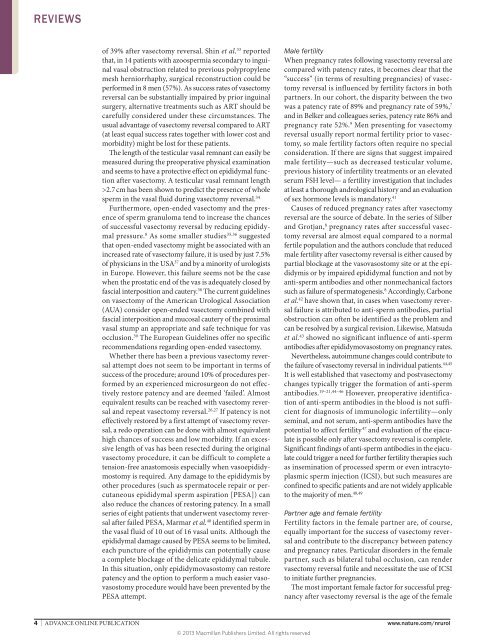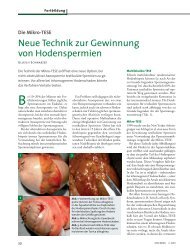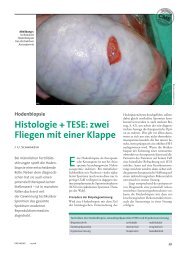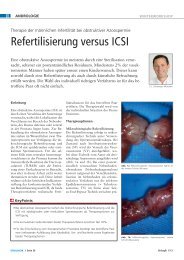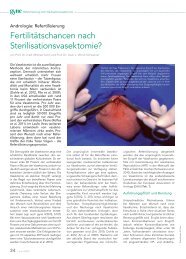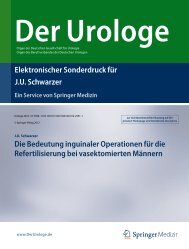nature.2013 - Andrology Center Munich
nature.2013 - Andrology Center Munich
nature.2013 - Andrology Center Munich
You also want an ePaper? Increase the reach of your titles
YUMPU automatically turns print PDFs into web optimized ePapers that Google loves.
REVIEWS<br />
of 39% after vasectomy reversal. Shin et al. 33 reported<br />
that, in 14 patients with azoo spermia secondary to inguinal<br />
vasal obstruction related to previous polypropylene<br />
mesh herniorrhaphy, surgical reconstruction could be<br />
performed in 8 men (57%). As success rates of vasectomy<br />
reversal can be substantially impaired by prior inguinal<br />
surgery, alternative treatments such as ART should be<br />
carefully considered under these circumstances. The<br />
usual advantage of vasectomy reversal compared to ART<br />
(at least equal success rates together with lower cost and<br />
morbidity) might be lost for these patients.<br />
The length of the testicular vasal remnant can easily be<br />
measured during the preoperative physical examination<br />
and seems to have a protective effect on epididymal function<br />
after vasectomy. A testicular vasal remnant length<br />
>2.7 cm has been shown to predict the presence of whole<br />
sperm in the vasal fluid during vasectomy reversal. 34<br />
Furthermore, open-ended vasectomy and the presence<br />
of sperm granuloma tend to increase the chances<br />
of successful vasectomy reversal by reducing epididymal<br />
pressure. 8 As some smaller studies 35,36 suggested<br />
that open-ended vasectomy might be associated with an<br />
increased rate of vasectomy failure, it is used by just 7.5%<br />
of physicians in the USA 37 and by a minority of urologists<br />
in Europe. However, this failure seems not be the case<br />
when the prostatic end of the vas is adequately closed by<br />
fascial interposition and cautery. 38 The current guidelines<br />
on vasectomy of the American Urological Association<br />
(AUA) consider open-ended vasectomy combined with<br />
fascial interposition and mucosal cautery of the proximal<br />
vasal stump an appropriate and safe technique for vas<br />
occlusion. 39 The European Guidelines offer no specific<br />
recommendations regarding open-ended vasectomy.<br />
Whether there has been a previous vasectomy reversal<br />
attempt does not seem to be important in terms of<br />
success of the procedure; around 10% of procedures performed<br />
by an experienced microsurgeon do not effectively<br />
restore patency and are deemed ‘failed’. Almost<br />
equivalent results can be reached with vasectomy reversal<br />
and repeat vasectomy reversal. 26,27 If patency is not<br />
effectively restored by a first attempt of vasectomy reversal,<br />
a redo operation can be done with almost equivalent<br />
high chances of success and low morbidity. If an excessive<br />
length of vas has been resected during the original<br />
vasectomy procedure, it can be difficult to complete a<br />
tension-free anastomosis especially when vasoepididymostomy<br />
is required. Any damage to the epididymis by<br />
other procedures (such as spermatocele repair or percutaneous<br />
epididymal sperm aspiration [PESA]) can<br />
also reduce the chances of restoring patency. In a small<br />
series of eight patients that underwent vasectomy reversal<br />
after failed PESA, Marmar et al. 40 identified sperm in<br />
the vasal fluid of 10 out of 16 vasal units. Although the<br />
epididymal damage caused by PESA seems to be limited,<br />
each puncture of the epididymis can potentially cause<br />
a complete blockage of the delicate epididymal tubule.<br />
In this situation, only epididymovasostomy can restore<br />
patency and the option to perform a much easier vasovasostomy<br />
p rocedure would have been prevented by the<br />
PESA attempt.<br />
Male fertility<br />
When pregnancy rates following vasectomy reversal are<br />
compared with patency rates, it becomes clear that the<br />
“success” (in terms of resulting pregnancies) of vasectomy<br />
reversal is influenced by fertility factors in both<br />
partners. In our cohort, the disparity between the two<br />
was a patency rate of 89% and pregnancy rate of 59%, 7<br />
and in Belker and colleagues series, patency rate 86% and<br />
pregnancy rate 52%. 9 Men presenting for vasectomy<br />
reversal usually report normal fertility prior to vasectomy,<br />
so male fertility factors often require no special<br />
consideration. If there are signs that suggest impaired<br />
male fertility—such as decreased testicular volume,<br />
previous history of infertility treatments or an elevated<br />
serum FSH level— a fertility investigation that includes<br />
at least a thorough andrological history and an evaluatio n<br />
of sex hormone levels is mandatory. 41<br />
Causes of reduced pregnancy rates after vasectomy<br />
reversal are the source of debate. In the series of Silber<br />
and Grotjan, 8 pregnancy rates after successful vasectomy<br />
reversal are almost equal compared to a normal<br />
fertile population and the authors conclude that reduced<br />
male fertility after vasectomy reversal is either caused by<br />
partial blockage at the vasovasostomy site or at the epididymis<br />
or by impaired epididymal function and not by<br />
anti-sperm antibodies and other nonmechanical factors<br />
such as failure of spermatogenesis. 8 Accordingly, Carbone<br />
et al. 42 have shown that, in cases when vasectomy reversal<br />
failure is attributed to anti-sperm antibodies, partial<br />
obstruction can often be identified as the problem and<br />
can be resolved by a surgical revision. Likewise, Matsuda<br />
et al. 43 showed no significant influence of anti-sperm<br />
antibodies after epididymovasostomy on pregnancy rates.<br />
Nevertheless, autoimmune changes could contribute to<br />
the failure of vasectomy reversal in individual patients. 44,45<br />
It is well established that vasectomy and postvasectomy<br />
changes typically trigger the formation of anti-sperm<br />
antibodies. 19–21,44–46 However, preoperative identification<br />
of anti-sperm antibodies in the blood is not sufficient<br />
for diagnosis of immunologic infertility—only<br />
seminal, and not serum, anti-sperm antibodies have the<br />
potential to affect fertility 47 and evaluation of the ejaculate<br />
is possible only after vasectomy reversal is complete.<br />
Significant findings of anti-sperm antibodies in the ejaculate<br />
could trigger a need for further fertility therapies such<br />
as insemi nation of processed sperm or even intracytoplasmic<br />
sperm injection (ICSI), but such measures are<br />
confined to specific patients and are not widely applicable<br />
to the majority of men. 48,49<br />
Partner age and female fertility<br />
Fertility factors in the female partner are, of course,<br />
equally important for the success of vasectomy reversal<br />
and contribute to the discrepancy between patency<br />
and pregnancy rates. Particular disorders in the female<br />
partner, such as bilateral tubal occlusion, can render<br />
vasectomy reversal futile and necessitate the use of ICSI<br />
to initiate further pregnancies.<br />
The most important female factor for successful pregnancy<br />
after vasectomy reversal is the age of the female<br />
4 | ADVANCE ONLINE PUBLICATION www.nature.com/nrurol<br />
© 2013 Macmillan Publishers Limited. All rights reserved


